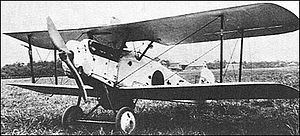Top speed 213 km/h Length 6.9 m Retired 1930 | Wingspan 8.5 m Introduced 1923 Designer Herbert Smith | |
 | ||
Manufacturer | ||
The Mitsubishi 1MF was a Japanese carrier fighter aircraft of the 1920s. Designed for the Mitsubishi Aircraft Company by the British aircraft designer Herbert Smith, the 1MF, also known as the Navy Type 10 Carrier Fighter was operated by the Imperial Japanese Navy from 1923 to 1930.
Contents
Development and design
The Japanese shipbuilding company Mitsubishi Shipbuilding and Engineering Co Ltd set up a subsidiary company, the Mitsubishi Internal Combustion Engine Manufacturing Co Ltd (Mitsubishi Nainenki Seizo KK) in 1920 to produce aircraft and automobiles at Nagoya. It quickly gained a contract from the Imperial Japanese Navy to produce three types of aircraft for operation from aircraft carriers: a fighter, a torpedo bomber and a reconnaissance aircraft. To produce these aircraft, it hired Herbert Smith, formerly of the Sopwith Aviation Company to assist the design of these aircraft, Smith bringing to Japan Jack Hyland and a team of six other British engineers .
The fighter designed by Smith and his team, designated the 1MF by Mitsubishi, and known as the Navy Type 10 Carrier Fighter by the Japanese Navy (referring to the year of design of 1921, the 10th year of the Taishō period), first flew in October 1921.
The 1MF was a single-seat, single-bay biplane with unequal-span wings and all-wooden construction, powered by a 224 kW (300 hp) Hispano-Suiza 8 engine (license produced as the Mitsubishi Hi engine). It was fitted with claw-type arrestor gear for use with British-style fore and aft arrestor cables.
After successful flight testing, the aircraft was accepted by the Japanese Navy as a standard fighter, with 138 of various versions being built, production continuing until 1928.
Operational history
The 1MF entered service with the Imperial Japanese Navy in 1923, replacing the Gloster Sparrowhawk. A 1MF aircraft became the first aircraft to take-off from and land on Japan's new aircraft carrier Hōshō on 28 February 1923. The 1MF series proved a tough and reliable aircraft, operating from the carriers Akagi and Kaga - as well as from Hōshō - when they entered service in 1927 and 1928 respectively. It continued in service until 1930, being replaced by the Nakajima A1N.
Variants
Operators
Specifications (1MF3)
Data from Japanese Aircraft 1910-1941
General characteristics
Performance
Armament
